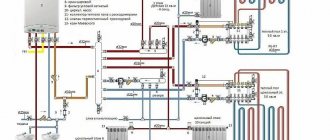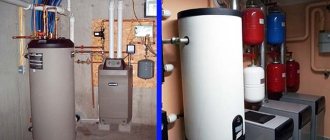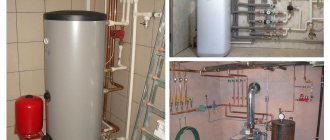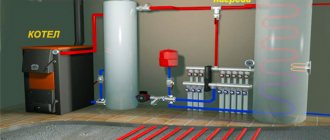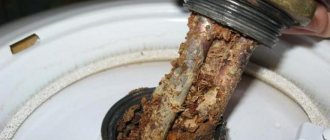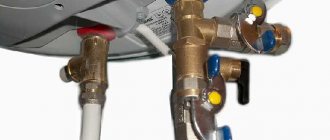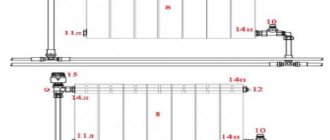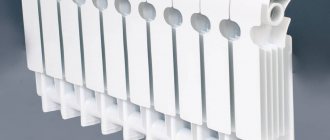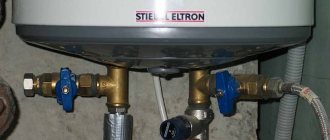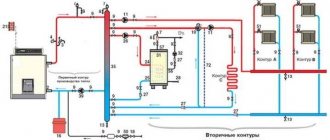Principle of operation
Boilers are floor-mounted, wall-mounted, or combined with a heat exchanger and a built-in thermal heating element. Unlike heating element water heaters, where there is direct contact with the heater, indirect heating boilers most often have a built-in coil in the form of a stainless steel pipe. The principle of operation is to transfer heat from the coolant moving along the coil to the water with which the tank is filled.
Due to this operating scheme, water is heated much faster than with a conventional heating element, scale formation is minimized and the tank will require maintenance much less often.
In this article we will look at connection diagrams for an indirect heating boiler:
- to a wall-mounted gas boiler;
- to a floor-standing gas boiler;
- electric boiler;
- to a solid fuel boiler.
DHW recirculation and its application
It often happens that in a country house the water treatment system is installed in a technical room, and it is located at a considerable distance from the residential area. In addition, most houses have several bathrooms on different floors. When designing a water supply system for such houses, engineers lay out a significant length of pipelines that contain a fairly large volume of water.
If the residents of the house have not used hot water for a long time, after some time the water in the pipes cools down. That is why, when you open a hot water tap, it takes time, sometimes quite a lot, until hot water, having flown through the pipeline, begins to flow from the tap. This not only creates certain inconvenience for the user, but also leads to excessive water consumption, especially if it comes from the city water supply.
To avoid this problem, when designing the hot water supply of a house, a recirculation unit is provided that maintains a constant or periodic flow of water in the hot water system. Thanks to this, hot water comes from the tap almost immediately.
You can install a DHW recirculation unit where a storage heater, an indirect heating boiler, or a second boiler circuit is responsible for heating the water. It should be noted that DHW recirculation implies a completely different layout of the water supply system. Therefore, it is best if it is developed at the stage of designing a house, since attempts to remake an existing system usually lead to high costs.
Connection diagrams
Connection to a wall-mounted single-circuit boiler
Typically, wall-mounted gas boilers are equipped with a built-in circulation pump and a valve responsible for switching between heating and the boiler heating circuit. In this case, there is no need to additionally install a circulation pump or three-way valve. It is enough to connect 2 pipes - supply and return, buy an additional temperature sensor for the boiler and use a full-fledged system.
An example of connecting an indirect heating boiler to a Buderus Logamax U072 boiler. All connections are located closer to the wall behind the boiler.
Coolant is supplied to the top of the heat exchanger from the boiler, passing through the coil and returning through the pipe to the boiler. This principle of connecting the boiler to an indirect heating boiler is used so that when water enters the tank. First, it began to be heated by a relatively cold section of the heat exchanger, and then by a hotter one.
Wiring diagram for an indirect heating boiler with a wall-mounted single-circuit boiler
Between the two systems on the supply and return, there must be a shut-off valve. Ball valves are installed near the boiler or at the inlet and outlet, directly to the water heater. The boiler is connected via a quick connector. This connection is provided for easy maintenance or replacement of the boiler if necessary.
If the ball valve is mounted near the boiler on the supply and return, then detachable connections are installed between the valve and the water heater. Wall-mounted single-circuit boilers are connected to an indirect heating boiler according to different schemes - if there is only one output, say supply, then the return can be shared with the heating system. There are 2 exits, both supply and return. Some electric boilers and gas boilers do not have an outlet for piping an indirect heating boiler. In this case, you need to purchase a boiler connection kit. But the kit must include a valve and a servomotor, which should be used to connect to the boiler automation.
This is what it looks like using a Baxi Ecofour gas boiler as an example:
And the kit for the Baxi Luna 3 boiler will already be like this (there is a three-way valve already built into the boiler itself):
Connection to a floor-standing single-circuit boiler
Connecting to a single-circuit boiler of the first type is, in principle, no different from the second. They also have a supply and a return - the supply is supplied from above, and the return is returned from below. The only caveat is that an air lock may form in the upper part. To prevent this, it is necessary to install an automatic air vent.
How to connect an indirect heating boiler to a floor-standing boiler? Floor-standing boilers do not have a built-in pump and a 3-way valve, so you will additionally need to install either a 3-way valve or a circulation pump. Let's take a closer look at the diagram of how to connect a boiler to a floor-standing boiler with a circulation pump.
We connect the return from the boiler directly to the floor-standing gas boiler using tees. We install the circulation pump on the return or supply. Don’t forget about shut-off valves - we install a ball valve before and after the pump, as well as a filter and check valve. When connecting the boiler, we install detachable connections: we install the ball valve only on the return side, because on the supply side we already have a ball valve installed near the pump. With this connection scheme, the pump is controlled by the boiler automation - it turns on and off depending on when the boiler needs to be heated.
Connection via manifold or hydraulic arrow
With the second connection option, the supply and return from the boiler with its own separate pump are connected after the hydraulic switch. After the hydraulic switch, a manifold wiring with its own separate pumps is usually installed, for example, on the underfloor heating circuit, on the radiator circuit, and the boiler heating circuit is also connected there, with its own separate pump. In this case, you will need additional automation that will control the boiler and all the pumps that are present in this circuit.
This connection scheme is well applicable for large houses of two or three levels. From the boiler, the supply goes to the collector, and there it is already distributed to the heating of each floor and to the indirect heating boiler.
There is only one problem left to solve - understanding when to heat the tank. To do this, you need to mount a thermostat with a submersible flask and connect it to the circulation pump. When the boiler cools down, the thermostat will signal the pump to turn on and vice versa.
Naturally, there are other options for connecting a boiler and boiler, but we talked about the most common schemes today.
Connection to a double-circuit boiler
Double-circuit boilers perform 2 functions: they provide the user with hot water, like an instantaneous water heater, and heating. In order to use the boiler only for heating or for hot water, that is, to connect the boiler to a double-circuit boiler and at the same time make it single-function, it is necessary to close the hot water supply tap from the DHW circuit.
Next, you connect the boiler as a single-circuit boiler, purchasing a special boiler piping kit for it.
Connecting the hydraulic accumulator
Let's consider connecting a boiler according to a hot water supply scheme - how a wall-mounted gas boiler connected to a boiler heats the heat exchanger. Cold water, rising through the pipe, passes through a coarse filter and then goes along the wall, straight to the boiler. Before connecting the cold water pipe to the boiler, it is necessary to install a ball valve with a detachable connection, which should be directed towards the tank. Then you should install a safety check valve, the so-called two in one. After this, install a tee to connect the hydraulic accumulator (expansion tank), and only then connect the cold water pipe to the boiler.
When connecting cold water, you need to follow exactly the above sequence:
- ball valve;
- safety check valve;
- expansion tank;
- connection to the boiler.
It is advisable to do such piping exactly at the entrance, that is, next to the boiler. A safety check valve for a boiler, as a rule, comes complete with a water heating device. If it is not included in the kit or is lost, you must purchase it. You can buy a safety check valve in a ready-made version or separately, that is, a separate safety valve and a separate check valve and connect them together. Cold water after the ball valve must pass through the non-return valve, and then through the safety valve and go to the expanded tank.
Example of a safety valve for a boiler
Before you buy a safety check valve, you need to look at the boiler’s data sheet at what pressure it should operate. Thus, we supplied cold water to the boiler, since we tied everything up correctly. At the hot water outlet, we just need to install a ball valve with a detachable connection, which must be installed between the tap and the boiler. If necessary, an expansion tank for the boiler can be installed and at the hot water outlet, for this purpose, a tee is installed between the tap and the boiler and the expansion tank is connected. Tanks can be universal, for hot or cold water supply, or only for hot water supply. The main thing is that the water temperature is working - up to +70 degrees.
Expansion tanks used for heating are not suitable for hot water supply. Expansion tanks for hot water systems are selected depending on the capacity of the boiler. As a rule, no less than 10% of the total volume.
It is recommended to select hydraulic accumulators with a little reserve:
- for 150 liters – 18 liter tank;
- for 200 liters - 25 liter tank.
Installation of an indirect heating boiler with an electric boiler
In this case the situation is slightly different. Compared to a gas boiler, there will be no difference in heating costs between an indirect heating boiler and an electric one, because In any case, heating comes from electricity. But the difference will be in the heating time (speed). If the power of the electric boiler is small, it is better to consider a conventional electric boiler (since you will not notice much of a difference in the heating rate, and the costs of a system with an indirect water heater will be much higher). If the power of the electric boiler is large enough (more than 7 kW), it is better to mount the system with an indirect heating boiler. Since the power of the heating elements of an electric boiler is only 1.5-2.2 kW, the time difference will not even be 2 times, but much greater. As for the choice of an electric boiler, taking into account the installation of an indirect heating water heater, it is better to pay attention to boilers with automation, which (using special components) allows you to connect the boiler directly to the boiler, so as not to be tricky with the wiring diagram in the future.
Connection diagram for an electric boiler with an indirect heating boiler: 1) indirect heating boiler, 2) heat exchanger for an indirect heating boiler, 3) shut-off valve, 4) hot water outlet, 5) distribution element, 6) shut-off valve, 7) electric boiler, three-way valve, 9) three-way valve drive, 10) cold water supply, 11) safety valve with check valve, 12) check valve in the direction of hot water circulation.
three-way valve, 9) three-way valve drive, 10) cold water supply, 11) safety valve with check valve, 12) check valve in the direction of hot water circulation.
Please note that from January 2021, a universal 3-in-1 electric boiler went on sale at a budget price from the Belarusian S-Tank plant - an electric boiler and an indirect heating boiler are integrated in one tank, as well as a hydraulic arrow and other useful things. Details can be found here.
Thus, regardless of the heat source (be it a gas, solid fuel or electric boiler), installing an indirect heating boiler is the optimal solution for the full and comfortable use of hot water.
Recirculation connection
Let’s assume that the indirect boiler is installed at a distance of 15 meters from the tap. In this case, if you open the tap, you will have to wait a while for hot water to flow from it. To implement the recirculation scheme, we find the farthest point of the hot water supply and, using a tee, connect another pipe, returning it back to the boiler. It turns out that we loop the system, install a special circulation pump for recirculation, for hot water supply, and after that hot water heated in the boiler will constantly circulate in our ring. Now, even at the farthest point, opening the tap, hot water will flow at the same second.
To minimize heat loss, all pipes through which hot water circulates from the boiler must be insulated with thermal insulation. Most boilers already have a special outlet for connecting the recirculation line. A special pump is installed on the line, designed specifically for DHW recirculation. Pumps that are used for heating are not suitable for this purpose. The pump is usually installed within one and a half meters from the boiler and connected with two taps. It is also recommended to install a strainer and a check valve. When connecting a pipe - recirculation line to the boiler itself, it is enough to install a quick connector. The tap does not need to be installed, since the tap is located on the pump itself. If the boiler does not have a special outlet for connecting the recirculation line, then we take a tee and install it at the cold water inlet, in front of the boiler.
The assembly of this connection unit occurs sequentially:
- ball valve with detachable connection towards the boiler;
- safety check valve;
- tee for connecting the expansion tank;
- tee for connecting the recirculation line;
- At the hot water outlet after the boiler, we install only a ball valve with a detachable connection towards the boiler.
With this piping scheme, if necessary, the expansion tank can be moved to the hot water outlet line from the boiler. Installation is made between the tap and the boiler. We connect the circulation pump with 2 ball valves with detachable connections. The detachable connections must be on the pump side. Also, do not forget to install a check valve. After installing this circuit, we get the same effect as with the boiler connection circuit, which has a special output for connecting the recirculation line.
